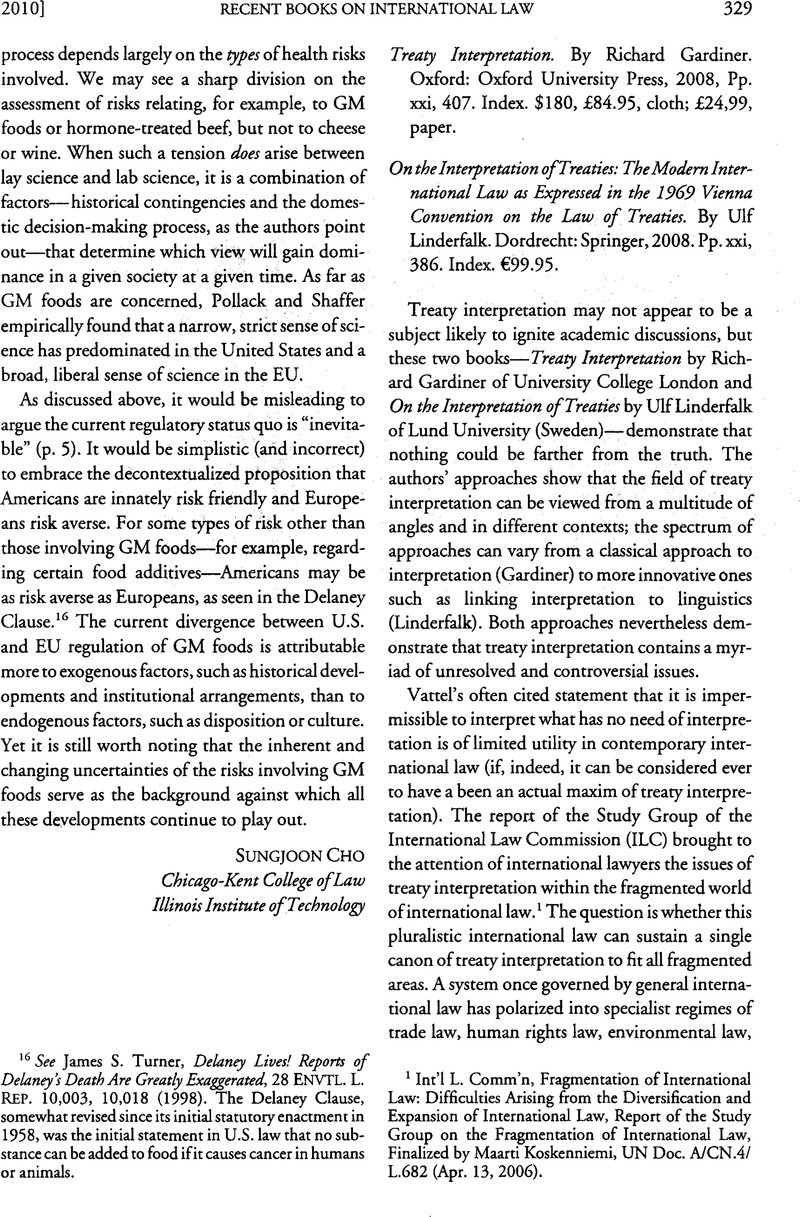Published online by Cambridge University Press: 27 February 2017

1 Int’l L. Comm’n, Fragmentation of International Law: Difficulties Arising from the Diversification and Expansion of International Law, Report of the Study Group on the Fragmentation of International Law, Finalized by Maarti Koskenniemi, UN Doc. A/CN.4/ L.682 (Apr. 13, 2006).
2 For example, the “MOX Plant” case was subject to different proceedings under three different conventions: the 1982 UN Convention on the Law of the Sea, the Convention for the Protection of the Marine Environment of the North-East Atlantic, and the European Community and Euratom treaties.
3 Campbell, Mclachlan The Principle of Systemic Integration and Article 31 (3)(C) of the Vienna Convention , 54 Int’l & Comp. L.Q 286 (2005).Google Scholar
4 UN Doc. A/CN.4/L.682, supra note 1, para. 35.
5 Maritime Delimitation and Territorial Questions Between Qatar and Bahrain (Qatar v. Bahrain), Jurisdiction and Admissibility, 1995 ICJ Rep. 6, para. 41 (Feb. 15).
6 Id. at 39 (Schwebel, J., dissenting).
7 Hersch, Lauterpacht Restrictive Interpretation and the Principle of Effectiveness in the Interpretation of Treaties , 1949 Brit. Y.B. Int’l L. 73.Google Scholar
8 Third Report on the Law of Treaties, UN Doc. A/CN.4/167 & Add.1-3, at 58 (1964) (Humphrey Waldock, Special Rapporteur).
9 Id. (footnote omitted) (quoted by Gardiner at p. 307).
10 In this context Gardiner quotes with approval the following statement of Waldock:
Recourse to travaux préparatories as a subsidiary means of interpreting the text, as already indicated, is frequent both in State practice and in cases before international tribunals. Today, it is generally recognized that some caution is needed in the use of travaux préparatoires as a means of interpretation. They are not, except in [reference to agreements, instruments, and documents annexed to a treaty or drawn up in connection with its conclusion], an authentic means of interpretation. They are simply evidence to be weighed against any other relevant evidence of the intention of the parties, and their cogency depends on the extent to which they furnish proof of the common understanding of the parties as to the meaning attached to the terms of the treaty. Statements of individual parties during the negotiations are themselves of small value in the absence of evidence that they were assented to by the other parties. (Id) (footnotes omitted) (quoted by Gardiner at p. 307) 1
11 Myres S. Mcdougal, Harold D. Lasswell, & James C. Miller (1967).
12 Richard, Falk On Treaty Interpretation and the NewHaven Approach: Achievements and Prospects , 8 VA. J. Int’l L. 323 (1968).Google Scholar
13 Gerald, Fitzmaurice Vae Victis or Woe to the Negotiator? Your Treaty or Our Interpretation of It , 65 Ajil 358, 370 (1971).Google Scholar
14 Id.
15 Challenges to textualism were not the exclusive domain of this school. In his seminal Function of Law in International Community, Hersch Lauterpacht argued that both individual interests and community interests may override the purely contextual interpretation of treaties. Also, in the jurisprudence of the European Court of Human Rights, community interests can, in certain circumstances, take precedence over textual interpretation.
16 McDougal and colleagues, see supra note 8 and accompanying text, also used the term “applier.”
17 Malgosia, Fitzmaurice Dynamic Interpretation of Treaties, Part I , 2008 Hague Y.B. Int’l L. 101. Part II will be published in 2010.Google Scholar